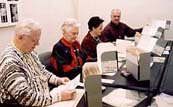
The Freedmen’s Bureau Preservation Project
Summer 2002, Vol. 34, No. 2 | Spotlight on NARA
By Reginald Washington
Post–Civil War era records that document the federal government's assistance to newly freed slaves—some of the most valuable records of the black experience in the second half of the 1800s—are now being preserved on microfilm by the National Archives and Records Administration (NARA).
The documents, nearly a century and a half old, rest in the narrow stacks at the National Archives Building in Washington, D.C. Some are torn, some even crumbling. Others are in good shape. They are all being carefully opened and inspected. Those in need of repair are sent to NARA's Document Conservation Laboratory in College Park, Maryland, for preservation treatment. Afterwards, they all will be organized and sent to be microfilmed to preserve them for generations to come.
Personnel from a number of NARA units—volunteers, archivists, archives specialists, archives technicians, conservators, conservator technicians, writers, editors, microfilm camera operators, and film processors—are working together in a five-year project to prepare, preserve, duplicate, and publish these records, considered some of the nation's most valuable and richest historical and genealogical documents.
Being preserved at NARA are the records of the Bureau of Refugees, Freedmen, and Abandoned Lands—generally known as the Freedmen’s Bureau. In the years following the Civil War, the Freedmen's Bureau, established March 3, 1865, in the War Department, provided assistance to tens of thousands of former slaves making the transition from slavery to freedom.
The bureau issued food and clothing, operated hospitals and refugee camps, established schools, helped freedmen legalize marriages, supervised labor contracts, and worked with African American soldiers and sailors and their heirs to secure back pay, bounty payments, and pensions.
A Valuable But Fragile Resource
The records are a rich source of documentation for the black experience in America for the second half of the nineteenth century. Over the years, historians, social scientists, and genealogists have used these increasingly fragile records to study and document the social and economic experiences of blacks in America during slavery and freedom as well as the federal government's policies toward them following the Civil War.
In recent years, however, more and more African American genealogists and family historians, with a great deal of frustration and varying degrees of success, have attempted to use the records for ancestral research. To do so, they had to come to Washington. This limited access has added to researcher frustration, and with frequent handling, the original records have become even more fragile.
Another problem with the Freedmen's Bureau records has been the lack of personal name indexes among the bureau's files that would allow easy access to the records when searching for freedmen and their families. In the absence of such indexes, researchers can spend countless hours searching through records that may or may not contain information about their ancestors.
Now, with authorization and funding from Congress, NARA is in the midst of a five-year project to microfilm and make available nationwide, as quickly as possible, all the records of the Freedmen's Bureau.
The project was made possible by congressional passage of The Freedmen's Bureau Preservation Act of 2000, which was signed by President William J. Clinton on November 6, 2000. The legislation was sponsored by Representatives Juanita Millender-McDonald (D-California); Stephen Horn (R-California), and J. C. Watts, Jr. (R-Oklahoma).
The act authorized three million dollars to preserve the more than one thousand linear feet of field office records of the Freedmen's Bureau (Record Group 105) in the custody of NARA's Old Military and Civil Branch. Congress appropriated the first installment—$450,000—in NARA's fiscal year 2002 budget.
The act also calls for the results of the Florida pilot project to be used to create partnerships with Howard University in Washington and other institutions "for the purposes of indexing these records and making them more easily accessible to the public."
Even before the law was enacted, the Freedmen's Bureau records for Florida were already being microfilmed under an agreement between NARA and the University of Florida. The Florida project, which is serving as a model for the other states to be filmed, has been completed and the Florida records will now be indexed.
With the Florida project completed, NARA is now preparing a separate microfilm publication of Freedmen's Bureau marriage records filed with the Bureau's Washington Headquarters in the Office of the Commissioner. These records are probably some of the most important records available for the study of black marriages before and after the Civil War.
Then, after the marriage records project, the other state records will be microfilmed in alphabetical order: Alabama, Arkansas, the District of Columbia, Georgia, Kentucky, Louisiana, Maryland and Delaware, Mississippi, Missouri, North Carolina, South Carolina, Tennessee, Texas, and Virginia.
Records Give Insight Into Black Experiences
Even though the Freedmen's Bureau was inconsistent in the kinds of records it created for each state, the surviving documents provide an opportunity for genealogists and historians to learn more about the black experience in those last days of the Civil War and years after the war ended, until the bureau itself closed shop in 1872.
Among the records, for example, are registers, lists, and applications of individual freedmen and families who received rations through the Freedmen's Bureau field offices. The records provide not only the names of people who received relief, but also their places of residence, the names of former owners, the reasons for their condition, and the extent to which the federal government attempted to prevent wholesale starvation and destitution in the aftermath of the Civil War.
The records also include thousands of labor contract agreements between freedmen and planters that were witnessed by bureau officials. These agreements give the names of contracting parties, the obligations and responsibilities of each party, the period of service and wages, and the type of work to be performed by freedmen. These records can be very useful for the study of black economic conditions and the federal government's "free labor" policies and its efforts to reconstruct the South.
Despite their shortcomings and limited availability, Freedmen's Bureau marriage registers, certificates, and licenses provide important information as well because bureau officials assisted thousands of couples in solemnizing marriage relations that they had entered into during slavery. The bureau's marriage records can contain dates of marriages, the minister who performed the ceremony, and in some cases, information about previous marriages and the number of children from these marriages. Many of the records document long-standing relations that couples had entered into during their enslavement. Historians have found these documents to be extraordinarily useful for the study of black family marital relations during the decades before and the few years following emancipation. For genealogists, the records have often been the only source of documentation of an enslaved ancestor's marriage.
Other bureau records—complaint and claimant registers, contracts of indentures, freedmen court papers, freedmen hospital registers, home colony registers, school and land reports, issuances and correspondence—contribute to a greater understanding of the many challenges and difficulties faced by the nearly four million former slaves.
To get these records ready for microfilming—and a permanent place in America's recorded history—staff from several units at NARA are involved.
Volunteers from the Civil War Conservation Corps conduct the initial preparation and processing of the Freedmen's Bureau records. Under the direction of an archivist from the Old Military and Civil Records unit, they flatten, folder, and assist in the general arrangement of the records for filming.
Then, Old Military and Civil Records staff archivists and specialists make image counts and identify records in need of conservation treatment before filming, and the records slated for treatment are then sent to the Document Conservation Laboratory.
Using the latest preservation techniques, the Document Conservation Laboratory staff repair damaged records and develop specially designed containers for the more than four thousand bound volumes found in Freedmen's Bureau files. Once the preservation process is completed, title pages and target sheets are inserted in the records by NARA staff, and they are then transferred for filming to the Special Media Preservation Laboratory at College Park.
Temporary staff has been hired to assist the Special Media Preservation Laboratory with microfilming and quality control, and editors and archivists develop introductory materials and descriptive pamphlets for each microfilm publication, describing the records and their content.
Once each state's records are finished, microfilm copies will be made available at each of NARA's Washington-area and regional microfilm facilities. The Florida microfilm is already available.
In a press conference last year at Howard University during African American History Month, John W. Carlin, the Archivist of the United States, spoke on the importance of the passage of the Freedmen's Bureau Records Preservation Act of 2000 and NARA's commitment to making Freedmen's Bureau records more accessible. Carlin remarked, "We at the National Archives and Records Administration are planning important steps to preserve these fragile and irreplaceable records and provide the widest access to them."

